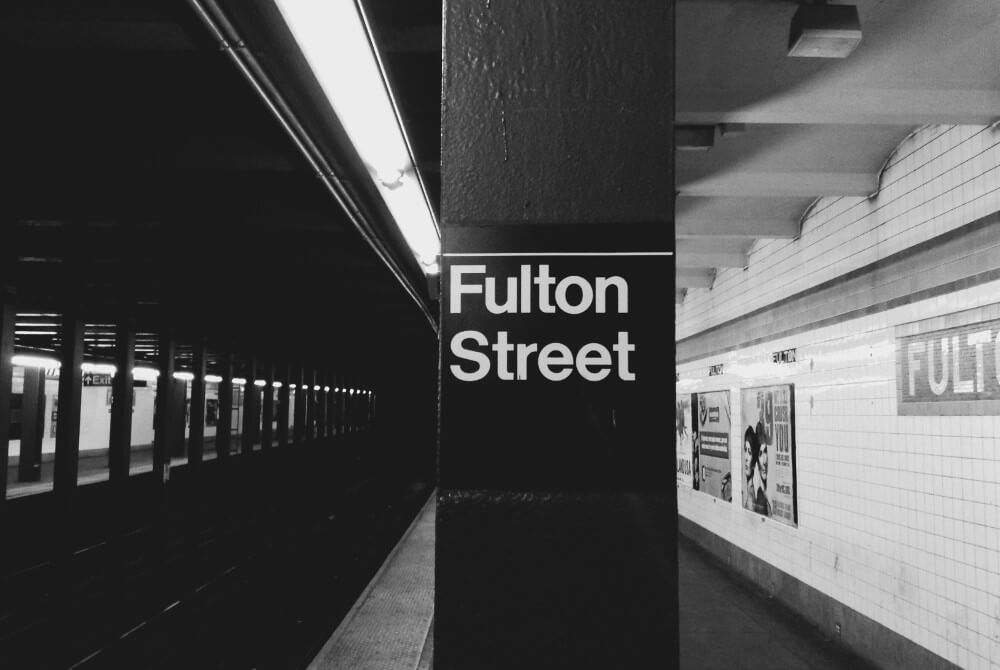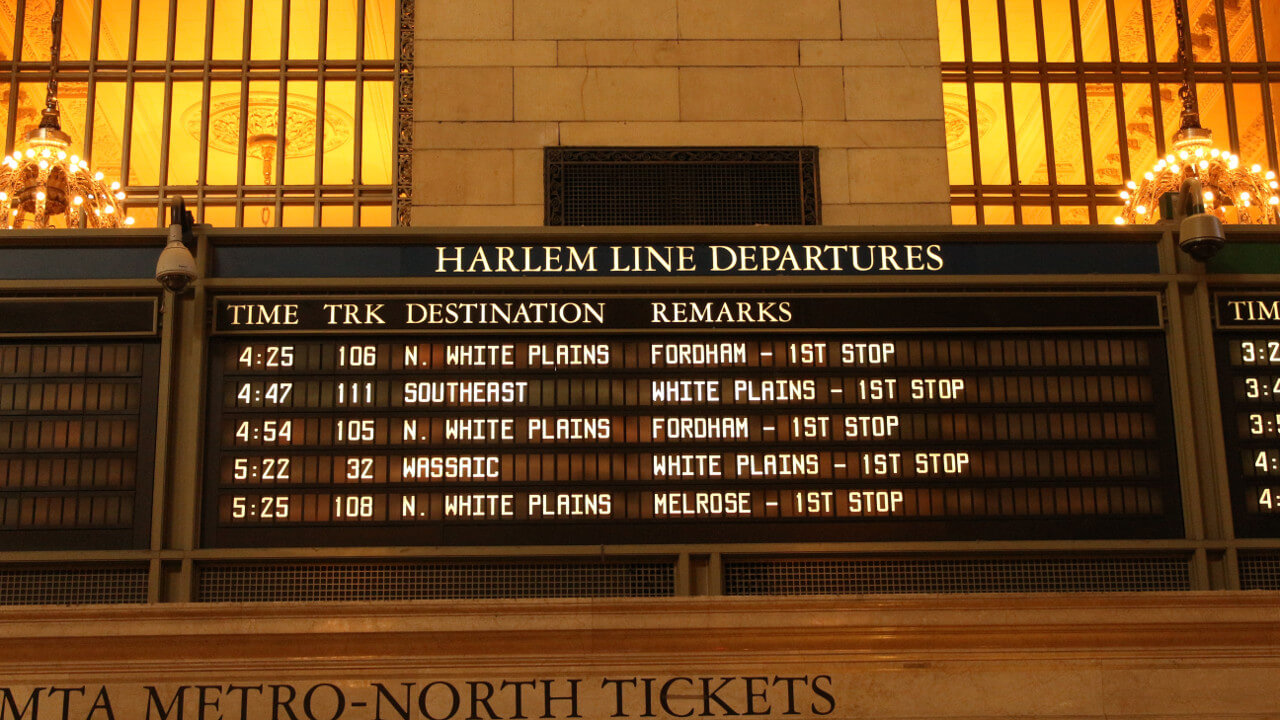New York Subway – The route network
Opened on October 27, 1904, the New York Subway is one of the oldest subway systems in the world. This factor should be taken literally in the case of the subway operated by the Metropolitan Transportation Authority (MTA). A large proportion of the routes, as well as much of the technology used, date back to the period between 1904 and 1940. Only a few sections of the New York subway were built in the period after that. Compared to other metro systems in other cities, the metro has not experienced extreme growth in later years.
Nonetheless, with 380 kilometers of track, the New York Metro ranks fourth among global subway networks after the subway systems in Beijing, Shanghai and the London Underground. The city’s 472 subway stations are connected by 12 tracks, including three so-called shuttles. All routes can be identified by a unique color on the New York Subway Map. Incidentally, each of these has a name that provides information about the course of the route (see list). As is common in many US cities, the subway in New York does not run exclusively in tunnels, but also partly above ground on elevated tracks.
The New York subway lines at a glance
- IRT Broadway – Seventh Avenue Line (red)
- IRT Lexington Avenue Line (green)
- IRT Flushing Line (purple)
- IND Eighth Avenue Line (blue)
- IND Sixth Avenue Line (orange)
- IND Crosstown Line (light green)
- BMT Nassau Street Line (brown)
- BMT Canarsie Line (light gray)
- BMT Broadway Line (yellow)
- IND Rockaway Line (dark gray)
- BMT Franklin Avenue Line (dark gray)
- IRT 42nd Street Shuttle (dark gray)
Information for tourists about the New York Subway Map
Things are different in the USA than in Old Europe, as one US president used to say in the recent past. This also applies to the New York subway. While in Europe there is usually no difference between the routes and lines, this is particularly the case in New York. The twelve routes are often divided into two to four lines. An exception are the extremely short shuttles, which are marked in dark gray on the New York Subway Map. The resulting 26 lines serve different branches and stop at certain times only at the most important subway stations (Express Lines). The New York Subway Map is standard equipment for every tourist to keep an overview.
The orientation of the subway network makes it easier for the 1.7 billion passengers a year, including many of the 50 million New York tourists, to find their way around. If you want to travel from north (uptown) to south (downtown) in New York, for example, you board a subway train marked “Downtown only”. Trains traveling in the opposite direction, “Uptown only”, usually depart from the opposite side of the station. The stations are also easy to identify as they are either named after a well-known building or the respective street or avenue.
Subway New York: Tickets & Prices
The New York operating company MTA relies on a uniform fare for the entire subway system. This makes using the metro very easy and convenient, even for non-residents.
The absence of paper tickets also makes traveling on New York’s most popular means of transport much more convenient. They were gradually replaced by the MetroCard from 1994 onwards. It is a plastic card with a magnetic stripe, which is available as a one-way ticket, multi-ride ticket or season ticket. Alternatively, the MetroCard can also be used as a credit card from which the fare for a single journey is automatically debited. What is interesting here is that there is a significant discount of almost 10 percent compared to a classic single journey.
One-way tickets are valid in New York, regardless of the direction of travel or the number of journeys, until you leave the subway through the turnstiles at the exit of the stations. However, as most visitors to New York want to use the subway for sightseeing, season tickets for any number of journeys within the validity period are a much better choice. All Subway tickets are also available in discounted versions. There are no special tourist cards in New York that include free entry to certain sights. Offers such as the “New York Explorer Pass” are available from various tourism companies without subway tickets.
The most important subway tickets in New York
| Ticket | Prices | Buy Tickets |
|---|---|---|
| Single ticket | 3.00 $ | available on-site |
| Single ticket (pay-per-ride) | 2.75 $ | available on-site |
| 7-Day Unlimited Ride | 32.00 $ | available on-site |
| 7-Day Unlimited Ride (erm.) | 16.00 $ | available on-site |
| 30-Day Unlimited Ride | 121.00 $ | available on-site |
| 30-Day Unlimited Ride (erm.) | 60.50 $ | available on-site |
Tickets for the New York Subway can only be purchased on site. Stations where the MetroCard is available either from a ticket machine or at a ticket counter are marked with a green circle or a green ball. Tickets are not available at stations marked with a red ball. Alternatively, the MetroCard is also available at many kiosks and in branches of the Duane Reade drugstore chain.
In contrast to many other subway systems, however, there is no need to rush after buying a ticket. The MetroCard only becomes valid when it is inserted into the slot of the electronic access barrier in front of the platform. As soon as the word “GO” appears on the lock display, you can pass through the turnstile and use the card until you leave the subway at your destination station. Season tickets, on the other hand, are valid for 7 or 30 days from this date.
New York subway schedule
The New York Subway occupies a special position in terms of its operation. It is one of the few subway trains that run continuously seven days a week. So night owls in New York don’t have to resort to expensive cabs to get from A to B, either during the week or at the weekend. However, not all lines operate around the clock. The current edition of the New York Subway Map shows exactly which ones. So it’s all the more important to get the latest issue on the spot. The timetable in New York can change at the weekend due to planned construction work. Information about alternative routes to attractions such as the Empire State Building or Times Square is then usually communicated via loudspeaker announcements in the subway stations.
As the subway in the Big Apple has no fixed timetable according to the New York Subway Map, travelers have to orient themselves according to the time of day. While the average interval between two trains on all lines is 10 to 15 minutes, this is considerably shorter during rush hour. Between 7:30 and 9:30 a.m. and between 4:30 and 6:30 p.m., New York’s subway lines are served by a train every 2-5 minutes. At night, however, the subway only runs every 20 minutes.
To the route maps of the New York subway lines
- IRT Broadway – Seventh Avenue Line(1, 2, 3)
- IRT Lexington Avenue Line(4, 5, 6, 6-Express)
- IRT Flushing Line(7, 7-Express)
- IND Eighth Avenue Line(A, C, E)
- IND Sixth Avenue Line(B, D, F, M)
- IND Crosstown Line(G)
- BMT Nassau Street Line(J, Z)
- BMT Canarsie Line(L)
- BMT Broadway Line(N, Q, R, W)
- IND Rockaway Line
- BMT Franklin Avenue Line
- IRT 42nd Street Shuttle
Further information about the New York Subway
Who is the biggest US movie star? George Clooney, Emma Watson, Angelina Jolie or Leonardo DiCaprio? All wrong. The real big Hollywood star is the New York subway. She has appeared in more blockbusters in recent decades than any Hollywood star. The New York Subway even plays a leading role in films such as French Connection (1971), Ghost (1990), Die Hard (1995), Money Train (1995), Man in Black 2 (2002), Spider-Man 2 (2004) and Knowing (2009).
However, if you want to discover the filming locations, you can’t do so on the usual traffic routes, as filming always takes place on disused sections of road. One of these particularly mystical sections is the secret subway station under City Hall, which opened in 1904 but was closed again in 1945. The trains became far too long for the platforms there. If you want to discover the historic station, take the 6 line (Lexington Avenue Line) and stay seated even after the official last stop in downtown Manhattan. To change direction back towards Uptown, the subway has to take the route through the “secret” “City Hall Loop” station.






